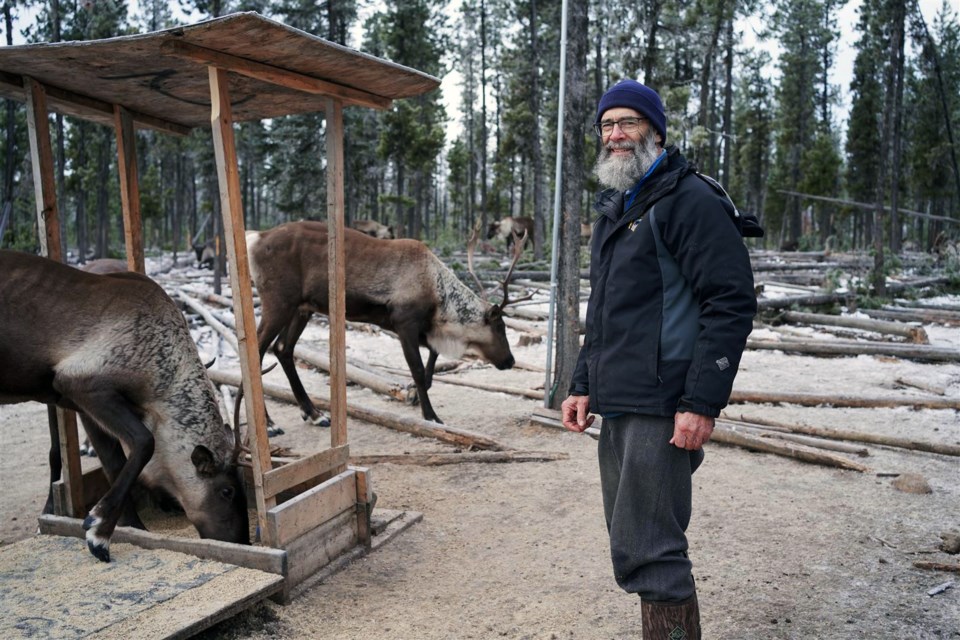Now Dasher, now Dancer, now Prancer, now Vixen!
On Comet, on Cupid, on Donner and Blitzen!
And don’t forget Rudolph.
Wildlife biologist Doug Heard has been assigning reindeer names for at least 10 years, just so he can keep track of all the mouths he has to feed as overseer of a herd of caribou that gathers each fall at the Kennedy Siding station, 160 kilometres north of Prince George.
It’s always a mystery if any of the gang gets selected for Santa’s delivery detail on Christmas Eve but Heard would certainly be qualified to recommend a few candidates for the job. Caribou are known as reindeer in Europe and Asia but they are the exact same species.
This year, he has about 150 subjects to monitor and knows some by names he’s given to them based on the appearance of their antlers. Not just males, but female caribou as well as calves grow antlers, which makes them unique among the deer family. Problem is, they shed their antlers every year and with that go their identities.
“I would like to have them all memorized each year but I don’t because there’s too many,” said Heard.
A dozen of them are wearing radio collars which allows them to be constantly monitored and others have their DNA samples stored in a database which helps with identification.
If he can’t identify them from year to year, Heard just gives them a new name and ID number. He calls them as he sees them – Dead Eye, Fuzz Butt, Limping, The Big Kahuna – and some are just names he likes – Dopey, Sneezy, Bingo and Ford F-150.
It just adds to the fun for the 73-year-old, who has found the ultimate retirement project to cap his 50-year career as a scientist.
“I think it’s good for science, it’s good for caribou recovery and it’s good for public relations, this kind of stuff, that people can go and see them,” said Heard.
The Highway 97 turnoff to the feed station is eight kilometres east of the Mackenzie Junction and then it’s another two kilometres on a well-maintained winter road. The ease of access makes watching the caribou feed a popular activity for nearby residents. The animals are quite used to people and they don’t mind posing for photos from the parking area but Heard said visitors should keep their distance and be wary of the bulls, especially during rutting season in mid-October when they are more aggressive.
The station, which is in operation from early-November to mid-January, has eight motion-triggered trail cameras, one of which is aimed at a weigh scale at one of the food boxes. As soon as the caribou steps on the scales, it trips the camera, which takes a photo of the scale readout so Heard can monitor each animal’s weight throughout the season.
In August, Heard set up a livestream camera link which allows viewers to watch the caribou as they feed. Powered by solar batteries, the live link is limited to four hours each day in the morning when they are most likely to feed. A stretch of cloudy days in November left the camera batteries uncharged, which temporarily wiped out the connection and Heard is trying to find a solution to the power problem.
Time-lapse clips of the feeding area are recorded daily and can be screened any time on a YouTube channel. There have been three cases of caribou shot and killed at the site and Heard was concerned the live stream camera would attract illegal hunters, but that has not happened and he’s pleased there have been no incidents of vandalism or theft at the station.
Heard started the McLeod Lake Indian Band Caribou Feeding Program in 2014 as an experiment to try to reverse years of steady decline of caribou numbers. The feeding started at the same time the B.C. government began to cull the wolf population in a 20,000 square-kilometre area of mountainous ungulate habitat that stretches from the Peace Arm of Williston Lake east to the Alberta border.
Different population management treatments were applied to three other areas adjacent to Kennedy Siding to determine which was best for increasing the size of the herd. In one area (Kinse-Za), a maternity pen was set up along with wolf culling, while the other two areas (Scott East and Quintette) had only wolf culls applied. Feeding the caribou proved the most effective.
“We started with 48 (in 2014) and last year we had 130 and I anticipate about 150 this year, so three times,” said Heard. “That’s the combined impact of feeding plus wolf removal.”
The feed station is supported by the province and the McLeod Lake Indian Band. Band member Destiny Rae restocks the food every other day while the station is operating. She lives near the site and delivers 10 20-kilogram bags of feed from a storage facility. The caribou eat, on average, one kilogram of supplied food each day, in addition to their main food source, lichen, and several kinds of plants.
The food pellets at the station are a highly-nutritious easily digested combination of alfalfa, beets, and other plant material designed to put weight on the caribou for the winter when foraging for food is more difficult. It costs about $10,000 to feed them for about three months.
Heard, a UBC graduate, has devoted much if his career to studying caribou and he worked 16 years in the Northwest Territories before moving to Prince George. He’s retired from his daily duties working for the province but remains active as a consultant working with other scientists on wildlife management efforts in other part of the province. He’s in the initial stages of creating a similar feed station for caribou near Barkerville.



